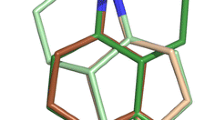Abstract
The pharmacophoric concept plays an important role in ligand-based drug design methods to describe the similarity and diversity of molecules, and could also be exploited as a molecular representation scheme. A three-point pharmacophore method was used as a molecular representation perception. This procedure was implemented for dopamine antagonists of the D2 receptor subtype. The molecular structures of the antagonists included in this analysis were categorized into two structurally distinct classes. Using structural superposition with internal energy minimization, two pharmacophore models were deduced. Based on these two models other D2 antagonists that fulfil them were derived and studied. This procedure aided the identification of the common 3D patterns present in diverse molecules that act at the same biological target and the extraction of a common molecular framework for the two structural classes. The pharmacophoric information was found to be suitable for guiding superposition of structurally diverse molecules, using a more biologically meaningful selection of the targeting points.








Similar content being viewed by others
References
Mason JS, Good AC, Martin EJ (2001) Curr Pharm Des 7:567
Bender A, Glen RC (2004) Org Biomol Chem 2:3204
Willett P, Barnard J, Downs G (1998) J Chem Inf Comput Sci 38:983
Kubinyi H (2002) J Braz Chem Soc 13:717
Jackson DM, Westlind DA (1994) Pharmacol Ther 64:291
Strange PG (1996) Adv Drug Res 28:314
Seeman P (1995) Sci Am Sci Med 2:28
Meltzer HY, Matsubara S, Lee JC (1989) J Pharmacol Exp Ther 251:238
Allen FH (2002) Acta Crystallogr B 58:380
Goede A, Dunkel M, Mester N, Frommel C, Preissner R (2005) Bioinformatics 21:1751
Horn F, Bettler E, Oliveira L, Campagne F, Cohen FE, Vriend G (2003) Nucleic Acids Res 31:294
Roth BL, Kroeze WK, Patel S, Lopez E (2000) Neuroscientist 6:252
Seeman P (2002) Can J Psychiatry 47:29
Kalani MYS, Vaidehi N, Hall SE, Trabanino RJ, Freddolino PL, Kalani MA, Floriano WB, Kam VWT, Goddard WA III (2004) Proc Natl Acad Sci USA 101:3815
Wouters J, Ooms F (2001) Curr Pharm Des 7:529
Bostrom J, Norrby PO, Liljefors T (1998) J Comput Aided Mol Des 12:383
Bostrom J (2001) J Comput Aided Mol Des 15:1137
Kirchmair J, Wolber G, Laggner C, Langer T (2006) J Chem Inf Model 46:1848
Lemmen C, Lengauer T, Klebe G (1998) J Med Chem 41:4502
Wolber G, Langer T (2005) J Chem Inf Model 45:160
Eliopoulos E (1984) The structure of β-lactoglobulin and the development of computer programs for the study of molecular conformations and interactions, Ph.D. thesis, Department of Biophysics, University of Leeds
van Wijngaarden I, Kruse CG, van Hes R, van der Heyden JA, Tulp MT (1987) A new class of potential antipsychotics. 1. J Med Chem 30:2099
van de Waterbeemd H, Testa B (1983) J Med Chem 26:203
Messer WS (2000) Medicinal chemistry II MBC 3320–neuroleptics. Neuroscience at the University of Toledo (retrieved from http://www.neurosci.pharm.utoledo.edu/MBC3320/neuroleptics.htm, 15 June 2006)
Henry DR, Guner OF (1995) Techniques for searching databases of three-dimensional (3D) structures with receptor-based queries. Electronic Conferences on Trends in Organic Chemistry (ECTOC-1)
Sheridan RP, Rusinko A III, Nilakantan R, Venkataraghavan R (1989) Proc Natl Acad Sci USA 86:8165
Matter H (1997) J Med Chem 40:1219
Olson GL, Cheung HC, Morgan KD, Blount JF, Todaro L, Berger L (1981) J Med Chem 24:1026
Thimm M, Goede A, Hougardy S, Preissner R (2004) J Chem Inf Comput Sci 44:1816
Lloyd EJ, Andrews PR (1986) J Med Chem 29:453
Froimowitz M, Riimsby S (1991) J Med Chem 34:1707
Acknowledgement
The authors would like to gratefully acknowledge Professor Stavros Hamodrakas for his advices and help.
Author information
Authors and Affiliations
Corresponding author
Rights and permissions
About this article
Cite this article
Atlamazoglou, V., Thireou, T. & Eliopoulos, E. Using a pharmacophore representation concept to elucidate molecular similarity of dopamine antagonists. J Comput Aided Mol Des 21, 239–249 (2007). https://doi.org/10.1007/s10822-007-9110-6
Received:
Accepted:
Published:
Issue Date:
DOI: https://doi.org/10.1007/s10822-007-9110-6




